I just installed an AEM wideband A/F gauge, and wow, tuning the Weber 32/36 is so much easier... There's already a huge improvement in driving. Anyway, from what I read you want to be as close to 14.7:1 as possible at low rpm's, but then more rich at higher rpm's. Since the Weber's idle circuit is used for such a wide rpm range, what's the point that you want to hit that 14.7 mixture by tweaking the idle mix screw? Is it at idle in park (about 900rpm for me)? Idle in drive (600)? Or a normal low speed driving rpm, like 2k-2.5k?
You are using an out of date browser. It may not display this or other websites correctly.
You should upgrade or use an alternative browser.
You should upgrade or use an alternative browser.
Tuning Weber carb with A/F gauge
- Thread starter kerb12
- Start date
The mixture screws and throttle stop screw is really only used for setting your curb idle RPM wether you have a stick trans (set idle in neutral) or for an auto trans (it's best to do final idle setting in drive with park brake set). All the rest of your settings to get the correct mixture at cruse speed is by the right setting of float level, adjusting the accelerator pump shot, and lastly finding the correct size of jets & air correction tubes, etc. Good luck on your tuning. 

Some updates with what I'm seeing so far... Also, I switched to a Weber 38/38.
- My engine idles pretty poorly at 14.7, and it picks up and has the strongest vacuum at about 13:1. Not sure if that's normal or not
- I can't seem to get a smooth strong idle at both park AND drive. If I tune for best park idle, then my drive idle goes even more rich (down into the 12's, and occasional dips into 11's). If I tune for best drive idle, then my park idle goes too lean and I have to turn my idle speed screw too far in to get the rpms back up
I'm still a beginner, but to me this sounds a lot like a vacuum leak from what I've read about other people that have similar problems... I can't seem to find one though (I sprayed carb cleaner around the carb-adapter and the manifold port for the C4 trans, and didn't get any increase in rpms).
The only thing I can think of is that my PCV is causing a problem. I know Clifford recommends not using one with Weber carbs, but I've also read that it hurts engine life without it, so I'm not so sure I want to take it out.
- My engine idles pretty poorly at 14.7, and it picks up and has the strongest vacuum at about 13:1. Not sure if that's normal or not
- I can't seem to get a smooth strong idle at both park AND drive. If I tune for best park idle, then my drive idle goes even more rich (down into the 12's, and occasional dips into 11's). If I tune for best drive idle, then my park idle goes too lean and I have to turn my idle speed screw too far in to get the rpms back up
I'm still a beginner, but to me this sounds a lot like a vacuum leak from what I've read about other people that have similar problems... I can't seem to find one though (I sprayed carb cleaner around the carb-adapter and the manifold port for the C4 trans, and didn't get any increase in rpms).
The only thing I can think of is that my PCV is causing a problem. I know Clifford recommends not using one with Weber carbs, but I've also read that it hurts engine life without it, so I'm not so sure I want to take it out.
14.7 is the ideal stoichiometric ratio if every molecule of fuel is completely burned with exactly the right number of molecules of oxygen. In the real world, fuel is usually suspended in droplets, clings to the port walls, sits as vapor unmixed in pockets; definitely not dispersed at a molecular level. Also keep in mind that swirl, quench, intake port wetting, and other mechanical factors will alter the way the fuel is eventually delivered and burned in the chamber.
Consequently, 14.7 is often too lean for most older engines to idle well. 13.0 - 14.0 is normally a better range for best idle. At WOT, accelerating, you should be seeing 11.5-12.5 and at cruise, with a very light throttle, you could be very lean at 14.5 - 15.5:1, maybe 16:1 with no load.
Consequently, 14.7 is often too lean for most older engines to idle well. 13.0 - 14.0 is normally a better range for best idle. At WOT, accelerating, you should be seeing 11.5-12.5 and at cruise, with a very light throttle, you could be very lean at 14.5 - 15.5:1, maybe 16:1 with no load.
Ah thanks so much, that's the exact info I was looking for! I think my floats might have been getting stuck too, giving me inconsistent readings, so I fixed that last night and upped my main jets and air correctors. I'll take it out for a test drive tonight and see how close I get to those numbers.
Right now I'm at:
Idle jets: 60 (both)
Main jets: 160 (both)
Air correctors: 190 (both)
Right now I'm at:
Idle jets: 60 (both)
Main jets: 160 (both)
Air correctors: 190 (both)
Well it seems mine is flipped - at very light load it's rich (13's) instead of lean, and it feels fine... on any normal accelerating it shoots way lean (high 17's) and I have very little power. There seems to be no difference between normal acceleration and WOT - they're all about the same leanness.
I've already gone up to 160 mains, which is the biggest that came with my jet kit. I could try smaller air correctors, but I had thought that they only have a real effect usually when you're at really high rpms.
The only thing I can think of to change at this point is the float level. It's currently at stock. I have a Holley fuel pressure regulator set at 3 psi as well, maybe my Mr Gasket gauge is wrong and I don't have enough pressure?
I've already gone up to 160 mains, which is the biggest that came with my jet kit. I could try smaller air correctors, but I had thought that they only have a real effect usually when you're at really high rpms.
The only thing I can think of to change at this point is the float level. It's currently at stock. I have a Holley fuel pressure regulator set at 3 psi as well, maybe my Mr Gasket gauge is wrong and I don't have enough pressure?
First, its not the peak fuel pressure from a Ford pump, its the surges up and down, and setting it at less than 3 psi takes care of it. So does using a stock Cater pump ex 1983-1985 302 4V HO, without a pressure regulator, but one return line. This is how all 1972 to 1992 Weber 2-BBL carbs were run in European and Australian cars in the 1.6 to 4.1 liter engines that ran these types of carbs. They used a bleed back valve, and there was no surge at the float bowl. The emulsion tubes were designed around a recommended float bowl setting, and the fuel pressure regulator is just a stop gap that works. People have funny ideas, a return line is the easiest way to take car of stock Ford pump pressure surges.
Float settings need to follow the recomendations used by Ford for the year and type of float.
The Stock Emulsion tubes vary depending on the type of choke, most European Weber 32/36 carbs are ex rear drive 1970-1983 Ford OHC engines like those found on some year 1.6/2.0 Capri/Taunus/Cortina/Transit/Granada/Sierra, and are sized to suit the vacuum needs of a 75 to 102 horsepower 97 to 121 cubic inch engine.
Depending on where they were sold (some were ECE emissions engines for Sweden and Switzerland, which used US 1973/1974 Pinto and 1976-1982 Australian Cortina jetting) and where they were made (Spain/Bressel/Weber), they have different set ups for float levels, return lines, float types with different settings, and base jetting and emulsion tubes. They didn't change that much. though, and there is a series number and details on them to figure out what should be there.
Stock emulsion tubes are Primary F50 /Secondary F6 on auto choke 32/36's, or Primary F50/Secondary F50 on manual choke.
The float levels need to be as recommended by http://www.mgexp.com/phorum/read.php?1,1976705,page=3
If you've set your float level right, and dropped the pressure by whatever means floats your boat, you then need to drop in two F66, F6, F7 or perhaps modified F7 with holes soldered up to stop lean conditions in the the cruise conditions. The jets and air correctors don't do much if the e-tube doesn't suit the engine size and vaccum requirements of a 200 Ford Six. The accelerator jet will help a little, but the two emulsion tubes will help the most. This is why, in 10 years of open sharing of info over the Weber 32/36, and Weber 38 and Holley 5200 series, there has been so little response to jetting changes.
On the Jeep forum, they have gotten into the Weber 61440.xxx emulsion tubes, and made some custom F-THIS ones very easily from some F7's to suit the 4.0 and 258 Jeep sixes with the 32/36 AND 38 series carbs.:mrgreen:
http://www.jeepforum.com/forum/f8/weber ... ndex6.html
Float settings need to follow the recomendations used by Ford for the year and type of float.
The Stock Emulsion tubes vary depending on the type of choke, most European Weber 32/36 carbs are ex rear drive 1970-1983 Ford OHC engines like those found on some year 1.6/2.0 Capri/Taunus/Cortina/Transit/Granada/Sierra, and are sized to suit the vacuum needs of a 75 to 102 horsepower 97 to 121 cubic inch engine.
Depending on where they were sold (some were ECE emissions engines for Sweden and Switzerland, which used US 1973/1974 Pinto and 1976-1982 Australian Cortina jetting) and where they were made (Spain/Bressel/Weber), they have different set ups for float levels, return lines, float types with different settings, and base jetting and emulsion tubes. They didn't change that much. though, and there is a series number and details on them to figure out what should be there.
Stock emulsion tubes are Primary F50 /Secondary F6 on auto choke 32/36's, or Primary F50/Secondary F50 on manual choke.
The float levels need to be as recommended by http://www.mgexp.com/phorum/read.php?1,1976705,page=3
I spoke to a technical representative at Pierce today. Here's what I found out:
1. The brass floated DGV carb should be set at 41 mm / 51 mm. (tab NOT compressing the ball valve on the needle valve). The needle valve will be telescoped inward on the needle valve mounting.
2. Measurements should be made from the base surface with the gasket on, not off.
3. The above measurements of 36.5 / 46.5 mm is only for a "composite" type floated carb using F50 and F6 emulsion tube pairing. This does not apply to the brass floated carbs.
I hope this helps. I didn't realize there were so many different configurations of the DGV carb.
If you've set your float level right, and dropped the pressure by whatever means floats your boat, you then need to drop in two F66, F6, F7 or perhaps modified F7 with holes soldered up to stop lean conditions in the the cruise conditions. The jets and air correctors don't do much if the e-tube doesn't suit the engine size and vaccum requirements of a 200 Ford Six. The accelerator jet will help a little, but the two emulsion tubes will help the most. This is why, in 10 years of open sharing of info over the Weber 32/36, and Weber 38 and Holley 5200 series, there has been so little response to jetting changes.
On the Jeep forum, they have gotten into the Weber 61440.xxx emulsion tubes, and made some custom F-THIS ones very easily from some F7's to suit the 4.0 and 258 Jeep sixes with the 32/36 AND 38 series carbs.:mrgreen:
Based on previous experiences and this most recent work, I'm going to offer up some broad generalizations while it's still fresh in my mind and wait for your feedback.
The activation point and also the mixture strength of the main circuit is controlled by the emulsion tube to a much greater extent than the main jet or air corrector. It also is the key to how well the main circuit responds to large throttle openings and overall mixture consistency, once activated.
The true mixture strength or sizing of the main jet is measured down lower in the rpm range (2,500 rpm) at WOT and is influenced to a lesser extent by the lower holes of the emulsion tube.
The WOT mixture at the top of the rpm range is most influenced by and adjusted with the air corrector
http://www.jeepforum.com/forum/f8/weber ... ndex6.html
Emulsion tube types and part numbers from Weber for your info.
You have stamped references, and part number references. You get good results with F6, F7 and F66's.(61440.211, 61440.226, 61440.220, respectively).
The US 5200 and its many variants have another kind of emulsion tube, called a Well Tube, and they haven't been unlocked yet for codes and hole arrangement, length, and inside and outside diameter. But any four cylinder sohc from the 70's to early 80's GM, FoMoCo, Chrysler and AMC will most likely have a Holley Weber Carb, with a too lean well tube. The exception should be the 74 (pn 14R 974) tubes from the Turbo 2300 carb engine, which should have a 6 cylinder suitable trim.
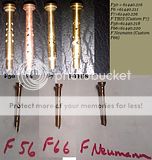
Top, Left To Right
F50 = 61440.216
F6 =61440.211
F7=61440.226
F THIS (Custom F7 by Swatson454 on the Jeep Forum)
Bottom Left To Right
F56=61440.218
F66=61440.220
F Neumann (Custom F66 by our AirBert)
Emulsion tubes from low power to bigger cubic inch generally go F50/F6/F66


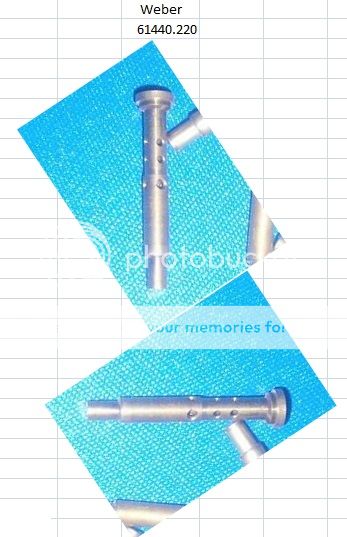
You'll find odd balls like Webers F71, F93, F110
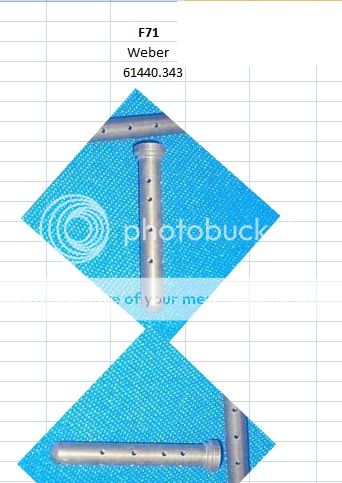
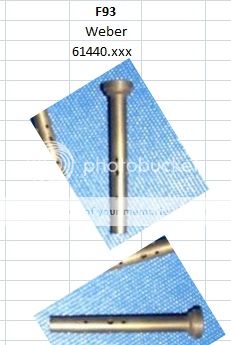

or Holley Webers 04, 05's, but there are Holley Weber 15, 16, 74 and 75's around ex AMC Gremlin 4 cylinders, Mopar Omni and K car, Chev Vega/Chevette and Tuurbo and non turbo Ford 2000 and 2300 cc OHC Pinto and Lima engines.
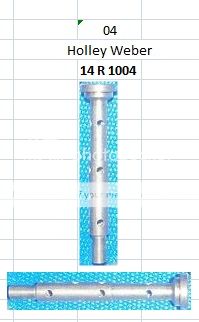
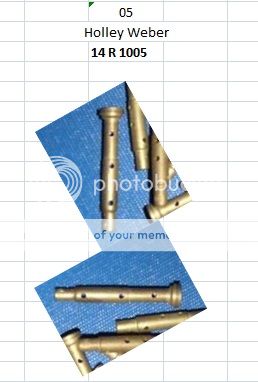
You have stamped references, and part number references. You get good results with F6, F7 and F66's.(61440.211, 61440.226, 61440.220, respectively).
The US 5200 and its many variants have another kind of emulsion tube, called a Well Tube, and they haven't been unlocked yet for codes and hole arrangement, length, and inside and outside diameter. But any four cylinder sohc from the 70's to early 80's GM, FoMoCo, Chrysler and AMC will most likely have a Holley Weber Carb, with a too lean well tube. The exception should be the 74 (pn 14R 974) tubes from the Turbo 2300 carb engine, which should have a 6 cylinder suitable trim.

Top, Left To Right
F50 = 61440.216
F6 =61440.211
F7=61440.226
F THIS (Custom F7 by Swatson454 on the Jeep Forum)
Bottom Left To Right
F56=61440.218
F66=61440.220
F Neumann (Custom F66 by our AirBert)
Emulsion tubes from low power to bigger cubic inch generally go F50/F6/F66



You'll find odd balls like Webers F71, F93, F110



or Holley Webers 04, 05's, but there are Holley Weber 15, 16, 74 and 75's around ex AMC Gremlin 4 cylinders, Mopar Omni and K car, Chev Vega/Chevette and Tuurbo and non turbo Ford 2000 and 2300 cc OHC Pinto and Lima engines.


Huh, interesting. I just assumed that since any Weber "calibration kit" that I've seen only includes jets, that it meant the emulsion tubes were rarely changed. I cracked the 38 open this morning and it does indeed have F50/F50 (which is the same as my 32/36). I'll order a pair of F70's and see how that works.
As far as float levels go, should they be the same between the 32/36 and 38/38 (assuming emulsion tubes are the same)?
As far as float levels go, should they be the same between the 32/36 and 38/38 (assuming emulsion tubes are the same)?
kerb12":2usv8479 said:Huh, interesting. I just assumed that since any Weber "calibration kit" that I've seen only includes jets, that it meant the emulsion tubes were rarely changed. I cracked the 38 open this morning and it does indeed have F50/F50 (which is the same as my 32/36). I'll order a pair of F70's and see how that works.
As far as float levels go, should they be the same between the 32/36 and 38/38 (assuming emulsion tubes are the same)?
Yes, the chart I posted has the lengths as well, laid out in landscape so you can compare them.

Stock lengths choices are 34.5 mm. The F7 (61440.226) is a better than the F70 (61440.197).
You'll find F78's in most Weber ICH/ICT 34 carbs we use for VW's and 200 Ford Offy/Edelbrock Tripower set ups, although it
34.5 mm 61440.xxx series e tube choices are
166(F2)
181,182, (F3, F5)
196,197, (F4, F70)
211, 212, 213, 217,218, 219, 223 (F6,F8,F24,F53, F56,F57,F80)
216,224 (F50,F81)
220,222 (F66,F78)
226(F7)
229(F87)
488 is the F25, and there is a F30 which is 33 mm, close enough, i'd guess, and others are valid as long as you use the recommended float level with them.2
Ok, ordered a pair of F7's, looking forward to getting those in...
On that mgexperience link you posted, someone posted this pdf:
http://www.mgexperience.net/article/all ... ations.pdf
Which actually says the stock float level on a 38 is different than a 32/36... 52.5/40 vs 46.5/36.5. I'm currently using a 32/36 float because I think my 38 one got messed up and was sticking. Looks like I should adjust that as well to match stock for a 38 at least.
What do you think about Clifford Performance's suggestion of setting it to 17.5mm from carb face to float instead?
On that mgexperience link you posted, someone posted this pdf:
http://www.mgexperience.net/article/all ... ations.pdf
Which actually says the stock float level on a 38 is different than a 32/36... 52.5/40 vs 46.5/36.5. I'm currently using a 32/36 float because I think my 38 one got messed up and was sticking. Looks like I should adjust that as well to match stock for a 38 at least.
What do you think about Clifford Performance's suggestion of setting it to 17.5mm from carb face to float instead?
What sub model is your 38?
Ford used it in the 3 liter Essex UK V6, and it only had a brass float, and was a 38DGAS3C
http://www.scimitarweb.co.uk/sgwrs/view ... =1&t=10794
When used in the Granada and Capri 2.8, it used the same carb
http://www.pistonheads.com/gassing/topi ... 61909&nmt=
Ford used it in the 3 liter Essex UK V6, and it only had a brass float, and was a 38DGAS3C
http://www.scimitarweb.co.uk/sgwrs/view ... =1&t=10794
When used in the Granada and Capri 2.8, it used the same carb
http://www.pistonheads.com/gassing/topi ... 61909&nmt=
Hmm, not sure, I bought it here and it doesn't mention what application it's for:
http://www.webercarbsdirect.com/38_DGES_p/18930.020.htm
It came with a plastic float.
http://www.webercarbsdirect.com/38_DGES_p/18930.020.htm
It came with a plastic float.
The Reliant manual and the Ford one give float height settings of 40.0 mm (brass) and 34.3 mm (plastic)
With F7's and the the F6 based F THIS Swatson 454 ran, he had a 18mm float drop, but its specified as 18mm from the gasket to the top of the float without depressing the ball and spring in the needle valve.
Some suppliers use the 38/52 float level with the F50 tubes, which is 14 mm float drop. Swatson 454 said the stock settings of 14mm float drop sounds pretty high
Factory defaults of 40/50 are way too high with a float drop of 10 mm, but they are for little PRV 2.6 V6's, Cologne 2.8 and UK Essex 3.0 V6's without a lot of low end vacuum. I6's have a lot more torque and low end vacuum.
On the Jeep Forum,
http://www.jeepforum.com/forum/f8/weber ... dex13.html
uptillnow and Swatson454 (Shawn) said this
Originally Posted by swatson454 View Post
Here's an example of what I'm talking about, courtesy of uptillnow.
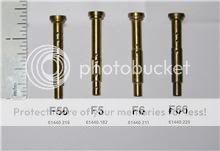
The pattern of large holes at the top of the F-50 bleed off an enormous amount of signal compared to the hole pattern of the F-6. This requires more rpm to finally pull fuel in from the main circuit. Unfortunately, by this time the idle jet has already given all its got and you end up with the lean spot you're seeing.
I hope it helps.
Shawn
Others have put DGES's on small M110 Twin Cam I6 Benzes, and found that they can get F43's, F61's and F50's to work, but they are smaller engines with more valve overlap
http://speedtalk.com/forum/viewtopic.php?f=1&t=26933
With F7's and the the F6 based F THIS Swatson 454 ran, he had a 18mm float drop, but its specified as 18mm from the gasket to the top of the float without depressing the ball and spring in the needle valve.
Some suppliers use the 38/52 float level with the F50 tubes, which is 14 mm float drop. Swatson 454 said the stock settings of 14mm float drop sounds pretty high
Factory defaults of 40/50 are way too high with a float drop of 10 mm, but they are for little PRV 2.6 V6's, Cologne 2.8 and UK Essex 3.0 V6's without a lot of low end vacuum. I6's have a lot more torque and low end vacuum.
On the Jeep Forum,
http://www.jeepforum.com/forum/f8/weber ... dex13.html
uptillnow and Swatson454 (Shawn) said this
Originally Posted by swatson454 View Post
Here's an example of what I'm talking about, courtesy of uptillnow.

The pattern of large holes at the top of the F-50 bleed off an enormous amount of signal compared to the hole pattern of the F-6. This requires more rpm to finally pull fuel in from the main circuit. Unfortunately, by this time the idle jet has already given all its got and you end up with the lean spot you're seeing.
I hope it helps.
Shawn
Typically in the 38-DGES we use the F50e-tubes, using more and larger air holes. Adjust the float level to 18mm from the gasket to the top of the float (without depressing the ball and spring in the needle vale). This typically works well for “most” applications. The F6, as Shawn stated has fewer air holes, and lower on the E-tube. With less air hole’s the main circuit will tip in sooner, and be a richer air fuel ratio. So now we would need to add some of that air we took away from the original F50 until we can get what we are looking for. The float level can add or subtract overall fuel volume at the tip in, or in the middle of the main circuit, or at high RPM or MAX power.
ARE YOU STILL CONFUSED??
Emulsion tubes become “black magic” when we don’t have a wide band O2 sensor or a way to measure fuel and power changes like a dyno.
Flame suit on… Shawn, get the fire extinguishers
Others have put DGES's on small M110 Twin Cam I6 Benzes, and found that they can get F43's, F61's and F50's to work, but they are smaller engines with more valve overlap
http://speedtalk.com/forum/viewtopic.php?f=1&t=26933
Ha, I guess no easy straightforward answer when it comes to modding these sixes huh? While I'm waiting for the new tubes I'm going to try setting the float to 18mm and see what happens. I ordered a spare float too, so if I screw this one up I can go back to stock.
By the way, I took a look at the carb this morning and the only identification I can see on it is "38DGES020" printed on the base plate next to the secondary idle mix screw. Next to that it says "11071" which I'm guessing is a serial number. Not sure if that tells you any more about which version this is.
Thanks again for the advice, I'll report back after I see how it runs with more fuel in the bowl.
By the way, I took a look at the carb this morning and the only identification I can see on it is "38DGES020" printed on the base plate next to the secondary idle mix screw. Next to that it says "11071" which I'm guessing is a serial number. Not sure if that tells you any more about which version this is.
Thanks again for the advice, I'll report back after I see how it runs with more fuel in the bowl.
kerb12":23436w36 said:Ha, I guess no easy straightforward answer when it comes to modding these sixes huh?
Yes there is.
I've grown so tired of talking about the return line being a way of not having to run a fuel pressure regulator. And how, overseas, the Weber32/36 and 38 are the carbs to run on just about any single carb instillation. From normal aspirated 1200 or 1300's to turbo 3 liters with 230 hp.
I'd use the stock European and Australian return line, and there float settings, emulsion tubes, and set the carbs up just like the 38 DGAS on Euro 2.8/3.0 v6's re 135 to 140 odd hp 2-bbl V6's and the staged Weber ADM 34 on the Aussie 82-92 Falcon 118 to 148 hp cross flow 200 and 250 I6's. They were all bleed back return line carb cars. When detoxed for the US, the 2.6 and 2.8 used the 32/36 or 5200, and got right up to 104 hp or so, and you can make a little staged Weber run just as hard as the the 38 DGAS or Weber ADM 34.
There are six float levels that Weber used on the list of 15 common DG series Weber carbs that my searches have supplied.

Brass 40
then 40_525
then 41_52
35_51
and 41_51
and 41 plus 11.5
It depends on the carb version too.
The drop measurement swatson454 and co use is not measured the way Weber does it, as he includes the gasket and free fall on the seat. F50/F6 combinations and nitrophyl floats are different.
uptillnow,swatson454 and wellmax says what I've been saying for about 13 years...use the return line and fiddle with float and e tube and jetting within the confines of the factory limits.The Jeep guys have got the technology by the short and curlies. We just have to be good disciples of good practice like Jeep, MG, Opel, Datsun 1200 modifiers.
Jeep guys (see below) have a special fuel filter which sorts out the bleedback plumbing, but the Weber has a return line from factory on all post 1972 versions.
http://www.jeepforum.com/forum/f8/weber ... st15227434
I just use the one line in and two lines out fuel filter,
note: ************** if you use this fuel filter system: the out, outside outlet of the fuel filter must be positioned at 12:00 high. center outlet goes to carb for fuel, outside out goes back to tank as a overflow for vent fumes or extra gas, (I think).
if you position it any other place, when the jeep sets for a long while, it will allow your system to syphon your fuel out of the carb and send it back to the fuel tank!!!!!!!!!!!!!!!!
then jeep will be hard to start after setting for over night, etc:
I think this double outlet fuel filter has something to do with maintaining the proper fuel pressure as the jeep runs fine with this setup and no fancy fuel pressure regulator.
If the Weber was hard to tune, why did Ford use it for so many years unaltered on performance European Capris, Granadas and Aussie Falcons?
These cars got excellent economy and power just by using a 4V Holley 4180C HO 302/351/460 style fuel pump.
Look at this!
http://images.thesamba.com/vw/gallery/pix/762780.jpg
http://images.thesamba.com/vw/gallery/pix/762781.jpg
Home made Weber 61440/Holley Weber 5200/6500 emulsion tubes from brake tube
http://www.thesamba.com/vw/forum/viewto ... &start=160
http://images.thesamba.com/vw/gallery/pix/762780.jpg
http://images.thesamba.com/vw/gallery/pix/762781.jpg
Home made Weber 61440/Holley Weber 5200/6500 emulsion tubes from brake tube
http://www.thesamba.com/vw/forum/viewto ... &start=160
Haha, now that is awesome.
I got my new tubes, but in the meantime I switched back to my 32/36 which runs pretty smoothly. It doesn't have as much power, and I still have to run it with the idle speed screw too far in for some reason, but it's very reliable. Hopefully I'll have some time to mess with the 38 again soon though because I loved the low end power it had...
I got my new tubes, but in the meantime I switched back to my 32/36 which runs pretty smoothly. It doesn't have as much power, and I still have to run it with the idle speed screw too far in for some reason, but it's very reliable. Hopefully I'll have some time to mess with the 38 again soon though because I loved the low end power it had...
Hi. Been running the weber 38 for a bunch of years now and while you can go crazy trying to get perfect AFR readings, I've found that close enough is good enough.
First, you are right that around 13.5:1 is going to give the best idle.
Second, remember that the idle jets control fuel for about the first third of your throttle travel and the main jets pick up from there. The air corrector jets will account for your AFR in the high revs, so if you are going to lean or too rich up towards the redline, that's where you'll be making air corrector changes.
Third, make one change at a time and work on it. I.e. Try to nail your idle jets first (idle to about 1800 rpm). When that seems close, try a couple of different mains. When the meat of the mains is good, then change your air corrector a if needed. Finally, when you just can't seem to get the curve right on your main to air corrector you should consider the emulsion tube changes.
Fourth, which should be first, make sure to follow the proper procedure for lean best idle adjustment as outlined here before making any other changes. Oh, and take notes as you go (number of screw turns out, etc...) http://www.redlineweber.com/html/Tech/3 ... unning.htm
I've gotten mine running just fine in a wide range of conditions: stock head with adapter, modified head, modified head on hi-po engine with lumpy cam, and finally that at 6000ft. So, it can be done but you need to be patient and methodical. That said, I find I need to run a little more rich than I'd like and I get poor mileage. Also, a little extra timing always worked better with this carb vs. the 32/36.
These are just my observations, though xctasy knows a lot more about this stuff than I do so it's not my intention to contradict shying he says, just add my own experience. I do find this carb fussy which is why I'm now doing this: viewtopic.php?f=51&t=72285
First, you are right that around 13.5:1 is going to give the best idle.
Second, remember that the idle jets control fuel for about the first third of your throttle travel and the main jets pick up from there. The air corrector jets will account for your AFR in the high revs, so if you are going to lean or too rich up towards the redline, that's where you'll be making air corrector changes.
Third, make one change at a time and work on it. I.e. Try to nail your idle jets first (idle to about 1800 rpm). When that seems close, try a couple of different mains. When the meat of the mains is good, then change your air corrector a if needed. Finally, when you just can't seem to get the curve right on your main to air corrector you should consider the emulsion tube changes.
Fourth, which should be first, make sure to follow the proper procedure for lean best idle adjustment as outlined here before making any other changes. Oh, and take notes as you go (number of screw turns out, etc...) http://www.redlineweber.com/html/Tech/3 ... unning.htm
I've gotten mine running just fine in a wide range of conditions: stock head with adapter, modified head, modified head on hi-po engine with lumpy cam, and finally that at 6000ft. So, it can be done but you need to be patient and methodical. That said, I find I need to run a little more rich than I'd like and I get poor mileage. Also, a little extra timing always worked better with this carb vs. the 32/36.
These are just my observations, though xctasy knows a lot more about this stuff than I do so it's not my intention to contradict shying he says, just add my own experience. I do find this carb fussy which is why I'm now doing this: viewtopic.php?f=51&t=72285
Similar threads
- Replies
- 75
- Views
- 4K
- Replies
- 25
- Views
- 1K
- Replies
- 19
- Views
- 2K
